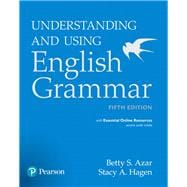For nearly forty years, Understanding and Using English Grammar has been the go-to grammar resource for students and teachers alike. Its time-tested approach blends direct grammar instruction with carefully sequenced practice to develop all language skills.
New to This Edition
- Pretests at the start of each chapter enable learners to check what they already know.
- Updated grammar charts reflect current usage and highlight differences between written and spoken English.
- A new chapter on article usage.
- A variety of high-interest readings include reviews, articles on current topics, and blogs that focus on student success.
- Additional incremental practice helps learners better grasp concepts, while thematic exercises and integrated tasks offer more contextualized language use.
- Step-by-step writing activities are supported by writing tips and pre-writing and editing tasks.
MyEnglishLab (access code provided in the book)
- Rich online practice for all skill areas: grammar, reading, writing, speaking, and listening.
- Instant feedback and remediation.
- Grammar videos.
- Bonus material not included in the Student Book, including additional expanded practice of gerunds and infinitives.
- Robust assessments.
- Gradebook and diagnostic tools.








